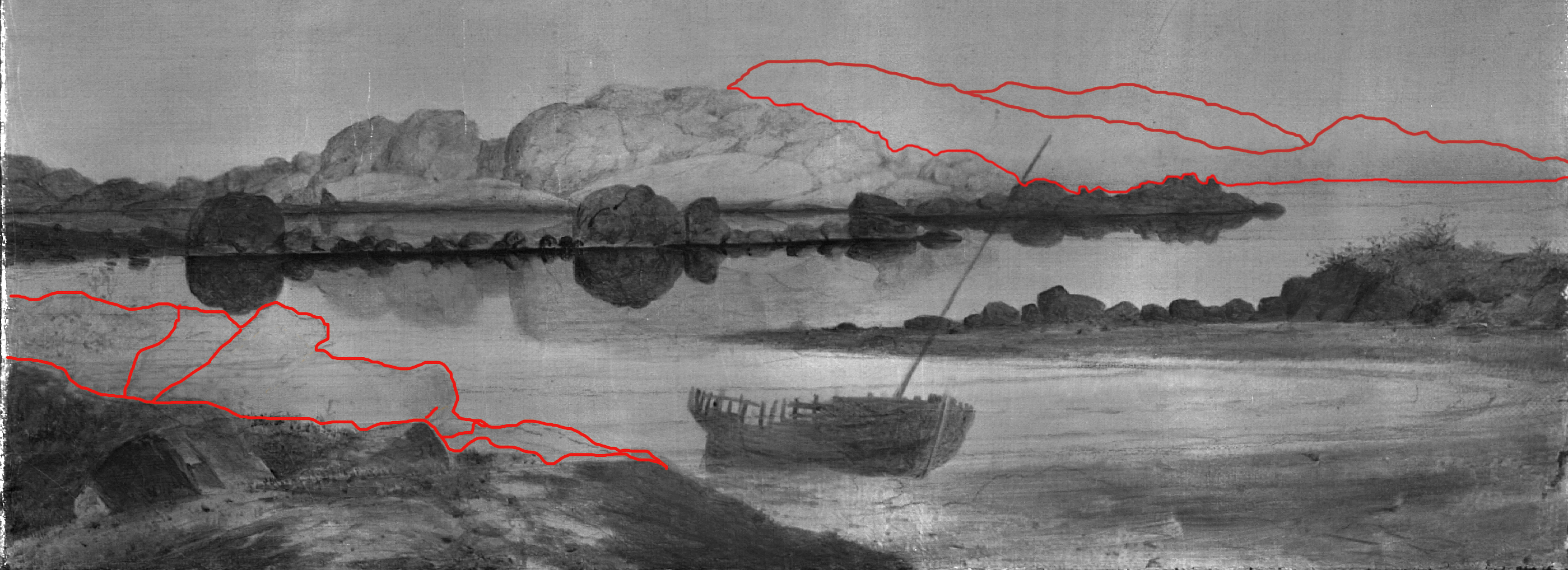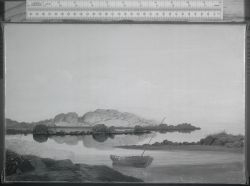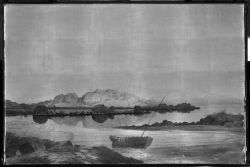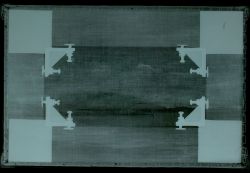An online project under the direction of the CAPE ANN MUSEUM
Catalog entry
inv. 73
Brace's Rock
Brace's Cove; Brace's Rock, Brace's Cove
1864 Oil on canvas 10 1/4 x 15 1/4 in. (26 x 38.7 cm) Signed and dated lower right: F.H. Lane 1864
|
Commentary
This version of Brace’s Rock is an anomaly in the series. The other paintings are taken directly from the field sketch and are faithful to it—to the extent that any Gloucester resident would immediately recognize the scene. With this painting Lane has turned Brace’s Cove on its head, and while the rock, though reversed, is clearly recognizable, the other features—the sandy cove, the foreground bushes, and the reef at low tide—simply don’t exist on that side of Brace’s Rock. The coast to the south is sheer granite cliffs dropping straight into deep water. It is hard to imagine Lane with his infirmities and failing health getting anywhere near the vantage point necessary to make a drawing of Brace’s Rock from that angle.
The rest of the scene simply does not exist and has been invented, lending the painting a surrealist feel. This is partially due to the juxtaposition of the incongruous landscape elements, but the perspective is also a bit skewed. The foreground cove with the abandoned vessel has a lower vanishing point than Brace’s Rock and the reef in front of it, which seem to hover over the still cove as if in a parallel universe. Adding to the surrealist vision is the rotting vessel on the beach, which looks as if a summer party stepped ashore for a picnic years ago and never returned.
While idealized or invented landscapes were common in nineteenth-century American art, for Lane they were very unusual. He had at least five commissions for Brace’s Rock paintings from his drawing, and presumably any patron who had commissioned a work would know the scene and expect a reasonably faithful representation. Infrared photography by the Cleveland Museum of the drawing on the canvas under the painting may have solved this mystery (see below).
The underdrawing shows mountains on the horizon identical to the Camden Hills in Maine, a subject Lane painted and drew numerous times. There are also major changes to the foreground cove and rocks, all well beyond Lane’s usual minor adjustments. On first seeing the underdrawing, Lane scholar John Wilmerding immediately connected the hills in the background with the Owl’s Head masterpiece of 1862, painted just two years before this work (see below). The foreground cove is also similar to those along the shore of the island from which Lane took the Owl’s Head view.
Is the mystery as simple as Lane having had a canvas of an identical size to the other Brace’s Cove paintings in his studio on which he had started and then abandoned an Owl’s Head painting? Did he then leave the beach, rocks, and foreground boat in place, paint out the mountains, and add the reef and Brace’s Rock, but facing the other way because the position of the beach and boats demanded it? That could also explain the oddly different worlds and perspective of the beach from the rock and reef beyond: they were painted at different times in different paintings.

X-ray image showing detail of mountains in underdrawing. Cleveland Museum of Art; Terra Foundation for American Art.

X-ray image with underdrawing of mountains and rocks highlighted. Cleveland Museum of Art; Terra Foundation for American Art.

Camden Mountains from the South West, 1855 (inv. 170) enhanced to show similar outline of mountains. Cape Ann Museum.
This is an interesting subject for speculation, all the more so for its being so unusual in Lane’s work. After all, he made interesting variations on three of the other versions, and six identical copies of anything can be tedious, even for Lane. He may have taken a convenient shortcut. Whatever its genesis may have been, this is a strange and wonderfully realized painting. Lane clearly spent time and effort on it and considered it a finished work worthy of signing and dating.
– Sam Holdsworth
Related Work in the Catalog
Supplementary Images
Provenance (Information known to date; research ongoing.)
Exhibition History
Traveled to: Terra Museum of American Art, Evanston, Ill., 20, 1980–1, 1981.
Traveled to: Goteborgs Konstmuseum, Gothenburg, Sweden, 6, 1986–15, 1987.
Traveled to: Museum of Fine Arts, Boston, Mass., 5–31, 1988.
Traveled to: Pennsylvania Academy of the Fine Arts, Philadelphia, Pa., 17–25, 2002; Minneapolis Institute of Arts, Minneapolis, Minn., 22–17, 2002.
Traveled to: Spanierman Gallery, New York, N.Y., 4–1, 2007.




The Braces Rock Series
The Brace’s Rock series of paintings is thought to comprise Lane’s last dated oils, painted in the fall and winter of 1863–64, not long before his death in August of 1865. Paintings of unusual peace and harmony, they present a fitting finale to Lane’s evolution as a painter. Each one is as much an ode to the bittersweet recollections of a late summer afternoon as it is a depiction of a familiar Gloucester landmark. Lane accomplished this without abandoning any of his fidelity to accurate depiction of place, season, and time of day.
Numerous writers have noted the symbolism of the decaying hull foundered on the rocks and the ebbing tide as markers of Lane's awareness of his own mortality. The paintings evoke an inescapable feeling of ennui in the preternatural calm of the sea, the limpid humidity of the still atmosphere, and the pink glow of the late afternoon sun off Brace's Rock. Knowing that these are Lane's last paintings, done in failing health in his studio throughout the course of his last winter, the viewer cannot escape the feeling that these paintings were a eulogy to his beloved Gloucester shoreline. Read on »